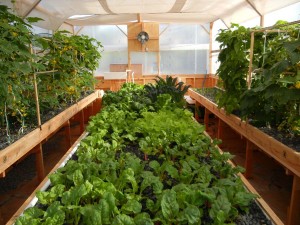What Makes Portable Farms® Aquaponics Systems Different?
– by Colle and Phyllis Davis
 Aquaponics can be traced back over 4,700 years to an area located in present-day China. The technology has been in use for a very long time. The older systems were referred to as pass-through or as one time water-use systems. This means the input water passes through the system in a series of steps to help in the production of meat, vegetables, fish and cleaner output water.
Aquaponics can be traced back over 4,700 years to an area located in present-day China. The technology has been in use for a very long time. The older systems were referred to as pass-through or as one time water-use systems. This means the input water passes through the system in a series of steps to help in the production of meat, vegetables, fish and cleaner output water.
Modern aquaponics tend to be closed loop systems where the water is recycled throughout the system. Portable Farms® Aquaponics Systems uses a ‘closed loop system’ similar to modern day hydroponics. The water is used to remove the waste from the fish tanks, deliver the nutrients (less the fish-waste solids) to the plants and then return the water which is now stripped of nutrients and re-oxygenated back to the fish tanks. The PFAS is different in several respects from most other aquaponics systems now in use.
In the 45 year design phase of the Portable Farms® Aquaponics Systems , the major parameters were to have a system that was easy to operate and very nearly indestructible. To achieve this dual goal the design required an overlay of software on the existing technology.

The best way to understand how this was accomplished is to use a computer or smart phone as an example. The hardware components of these devices are very similar and can be manufactured by a wide variety of companies. The differences between the different brands or models lie in the software used to operate the equipment. The software is designed to take advantage of the hardware and be flexible enough to accept apps or programs in order to add functionality to the device itself.
The Portable Farms® Aquaponics Systems is designed exactly the same way. The basic technology of aquaponics is a commodity or open-sourced material where anyone can actually build an aquaponics system using information gathered from the Internet and materials gathered locally. The difference is that the Portable Farms® Aquaponics Systems is the software package that makes the collection of components operate at peak efficiency and is also flexible enough to allow for changes due to environmental conditions, crops differences and emergencies.
 There is no single point of failure in a commercial Portable Farms® Aquaponics Systems installation. This huge safety factor is achieved because each Module is a stand-alone system with two separate points of failure, neither of which is critical to the health of the fish or plants for up to twelve hours. IF a single Module were to fail, it will not in any way jeopardize the entire installation. If a single Module fails in a Commercial Installation it represents less than 5% of the output of that installation. A computerized warning system can be installed to notify one or more people of any impending or actual failures that may occur.
There is no single point of failure in a commercial Portable Farms® Aquaponics Systems installation. This huge safety factor is achieved because each Module is a stand-alone system with two separate points of failure, neither of which is critical to the health of the fish or plants for up to twelve hours. IF a single Module were to fail, it will not in any way jeopardize the entire installation. If a single Module fails in a Commercial Installation it represents less than 5% of the output of that installation. A computerized warning system can be installed to notify one or more people of any impending or actual failures that may occur.
This technology analogy is the best and probably the only way to explain the enormous advantage that Portable Farms® Aquaponics Systems has over other aquaponics systems. This is especially true when compared to the raft systems which consume many times as much water and electrical power than medium-based systems (we use gravel). Most raft systems have a single-system-wide point of failure which is an electrical pump that is running at all times. When/if this pump fails, the system immediately puts the fish at risk and very quickly the fish will die. The best software in the world cannot workaround this design flaw.
- For commercial installations our PFAS LLC engineers are onsite to oversee the initial setup and to train the local crew(s) on how to properly assemble and operate the system.
Aquaponics makes controlled environment growing more than a feasible addition to the food supply. It makes feeding a growing middle class a lucrative and rewarding investment. The Portable Farms® Aquaponics Systems is the most advanced, best producing, least energy intensive aquaponics system in the world. Start yours today.

2 comments
We will be slowly changing our source of income from our family business to a small farming business. Our ultimate goal is to grow protein and vegetables, year long in a sustainable environment.
I am very pulled towards your products and doing lots of research. Making sure that I look at most of whats available before I put my eggs all in one basket.
Forgive me, I try to find my own answers before sending in questions and taking up your time. I was first introduced to soiless growing from the person who teaches that gravel is all you need and the gravel will feed your garden for a lifetime, no soil, no fertilizers, nothing but water and gravel.
You use gravel but obviously it isn’t all that is needed.
The internet is great but can be just as confusing.
Thank you,
Shannon
Author
Shannon,
You need more than gravel. You need fish poop, water and some micro-nutrients. Plants need all three especially water. The best place to start with a commercial aquaponics business is our new book Commercial Aquaponics Gold.
Yes, do your research and only move forward when you are satisfied that the project will work for you and your family.
Colle